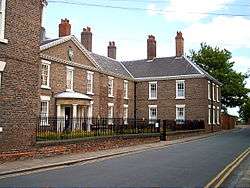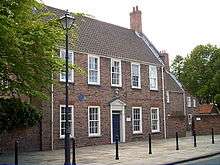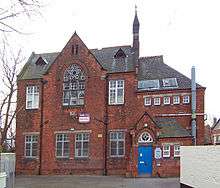Charterhouse, Kingston upon Hull
The Charterhouse (Hull Charterhouse) was a Carthusian monastery and almshouse in Kingston upon Hull, England, built just outside the town's walls. The hospital building survived the Dissolution of the Monasteries; the priory was destroyed in 1538. The structure of the hospital was destroyed before the first siege of Hull during the English Civil War. A replacement was built in 1645, which was replaced again in 1780; the buildings function as an almshouse with an attached chapel, and remain in use to the present day (2012).
 The Charterhouse (built c. 1780) | |
| Monastery information | |
|---|---|
| Full name | Hull Charterhouse |
| Order | Carthusian |
| Established | 1377 |
| Disestablished | 1538 |
| Dedicated to | Saint Michael |
| Site | |
| Location | Kingston upon Hull, England |
The 1.65 hectares (4.1 acres) area around and including the Charterhouse was designated a conservation area in 1975, which includes a Victorian board school – Charterhouse School – and an 18th-century burial ground.[1]
History

According to Tickell in The History of the Town and County of Kingston Upon Hull (1796), there was a religious house at the Charterhouse site from the time of Edward I.[2]
It is certain that the land became the property of William de la Pole in the 14th century. He established a hospital there, known as the Maison Dieu, around 1350. According to the Chronicle of Melsa, during William's life there was at one time a community of thirteen men and two women living there, as well as a college of six priests; as a result of conflict within and without the community they were removed, and later the Friars Minor occupied the place. William had acquired a license from Edward III to establish a monastery there, and intended to found one for the Poor Clares, but died before it could be completed. His son, Michael de la Pole, completed the foundation of a monastery in 1377, dedicated to Saint Michael, to house thirteen monks of the Carthusian Order.[3][4][5] William, Duke of Suffolk (great-grandson of William the founder) was buried here by his widow, Alice Chaucer, as was his wish, this being their family church (and not in the Wingfield church as is sometimes stated).
The monastery income in 1535 was over £230, with a net income of £174 18s 3d, but was not dissolved by the Dissolution of the Lesser Monasteries Act, and received license to continued from the King.[6] It was suppressed in 1538, and the priory was destroyed.[7] The hospital had been rendered to the crown in 1506 on account of the actions of Edmund de la Pole, 3rd Duke of Suffolk, but was restored in 1553 to the mayor and burgesses of Hull.[8] The hospital became known as the Charterhouse after the former priory.[9]
In the English Civil War the hospital building was demolished, before the First Siege of Hull (1642), to prevent it being used by besieging forces.[10] It was rebuilt in 1645 at a cost of £474;[11] further cells and a chapel were built from 1663 to 1673.[12] It was rebuilt again in 1780, and extended in 1803.[11] By the 1860s the hospital cared for 70 pensioners, each with an allowance of 6s per week.[13]
The Master's House is thought to incorporate part of the 1650 hospital,[14] it was damaged during the Second World War, and restored in 1950.[15] Both the Charterhouse and Master's House are listed buildings.[15][16]
As of 2002 the Charterhouse still functioned as an almshouse.[17]
Charterhouse School

The nearby Charterhouse School to the east of the present Charterhouse is a Victorian development – a board school designed by William Botterill, built in 1881. The school consists of a single-storey infants' school, and a two-storey segregated school, with separate boys' and girls' entrances; the girls' classrooms were on the first floor. It became a secondary school in 1950.[18]
In 1967 the school became an annexe of Hull College.[19] By 2015, the site had been sold by the College.[20]
References
- Charterhouse Conservation Area (2010), sections 2.1–2.2
- Page 1974, para. 1.
- Gent, Thomas (1869) [1735]. Annales Regioduni Hullini : Or, The History of the Royal and Beautiful Town of Kingston-upon-Hull. pp.68–71.
-
- Kingsford, Charles Lethbridge (1896). Pole, William de la (d.1366). Dictionary of National Biography, 1885–1900. 46. p. 50., via wikisource
- de Burton, Thomas (1866) [1396]. Bond, Edward A. (ed.). Chronica Monasterii de Melsa, a Fundatione Usque ad Annum 1396, Auctore Thoma de Burton, Abbate. Accedit Continuatio ad Annum 1406. Rerum Britannicarum medii aevi scriptores (Chronicles and Memorials of Great Britain and Ireland during the Middle Ages) (in Latin and English). 1. Longmans, Green, Reader and Dyer. p. 170.
De cujus herede per successionem dominus Michael de la Pole, comes Suffolechiae, acquirens terras hereditatis suae in Suttona et Sculeottes, dedit eas monasterio Sancti Michaelis ordinis Cartusiensis juxta Kyngestonam super Hullo. Quod coenobium dominus Williebnus de la Pole, miles, primus major dictae villae de Kyngestona super Hullo, ipsas terras de Mytona per nos regi in escambium concessas de rege acquirens, circa annum Domini 1350, infra territorium de Mytona fundavit. Extra cujus coenobii portiis, domum unam xiii virorum et aliam totidem foeminarum instituit, concedens singulis viii. denarios septimanatim; et infra portas conventum monachorum de monasterio nostro inhabitare proponebat: sed unde viverent eorum successores non-providens, collegium sex sacerdotum ibidem ordinabat; qui tamen, propter dissensiones inter se commotas, amoti fuerunt. Deinde conventum fratrum Minorum illuc introduxit; qui etiam inde recesserunt. Tandem, mortuo dicto domino Willielmo, praefatus Michael, filius et heres suns, circa annum Domini 1376, Carthusienses ibidem stabilivit; qui ibidem possessionibus et ecclesiis dotati perseverant.
- Page 1974, para. 5.
- Sheahan 1864, pp. 355–6.
- Sheahan 1864, pp. 455–6.
- Charterhouse Conservation Area (2010), section 3.5
- Sheahan 1864, p. 116.
- Sheahan 1864, p. 456.
- Charterhouse Conservation Area (2010), section 3.7
- Sheahan 1864, p. 457.
- Charterhouse Conservation Area (2010), section 3.8
- Historic England. "Masters house at Hull Charterhouse and attached boundary wall (1293252)". National Heritage List for England. Retrieved 11 December 2012.
- Historic England. "Hull Charterhouse and attached boundary wall and railings (1208200)". National Heritage List for England. Retrieved 11 December 2012.
- "Through the keyhole". Hull in Print. Hull City Council. April 2002. Retrieved 7 October 2012.
- Historic England. "Former Charterhouse school (1197630)". National Heritage List for England. Retrieved 11 December 2012.
- Charterhouse Conservation Area (2010), section 6.2.3
- "04/12/2015 Homes for Heroes in Hull". Breakfast BBC Radio Humberside. BBC. Retrieved 4 December 2015.
Sources
- Page, William, ed. (1974). "Houses of Carthusian monks: 4.3 Priory of Kingston-upon-Hull". A History of the County of York. 3. pp. 190–192.CS1 maint: ref=harv (link)
- Page, William, ed. (1974b). "Hospitals – 131. Charterhouse Hospital, Hull". A History of the County of York. 3. pp. 310–313.CS1 maint: ref=harv (link)
- Sheahan, James Joseph (1864). General and concise history and description of the town and port of Kingston upon Hull. Simpkin, Marshall, & Co.CS1 maint: ref=harv (link)
- "Charterhouse Conservation Area Character Appraisal" (PDF). Hull City Council. July 2010. Archived from the original (PDF) on 4 October 2013.
Literature
- Cook, John (1882). The History of God's House of Hull, Commonly Called the Charterhouse.CS1 maint: ref=harv (link)
Locations
- 53.748924°N 0.332599°W, Charterhouse (current)
- 53.748619°N 0.332710°W, Master's House, Charterhouse
- 53.748990°N 0.335365°W, Priory (site of)
- 53.748658°N 0.332092°W, Charterhouse school (primary)
- 53.748353°N 0.332021°W, Charterhouse school (mixed)
External links
| Wikimedia Commons has media related to Charterhouse, Kingston upon Hull. |
| Wikimedia Commons has media related to Charterhouse School, Kingston upon Hull. |
- Historic England. "Carthusian Priory of Kingston upon Hull (78922)". PastScape.
- "Records of The Charterhouse, Hull". National Archives.